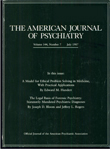Sex reassignment surgery: historical, bioethical, and theoretical issues
Abstract
The reported 68%-86% overall success rates for sex reassignment surgery must be viewed cautiously; the lack of long-term follow-up studies makes these statistics misleading. There is evidence suggesting that some gender dysphoric patients benefit primarily from sex reassignment surgery. Most such patients, however, are secondary transsexuals who can benefit from various modes of psychotherapy. Sex reassignment surgery should only be considered as the last resort for a highly select group of diagnosed gender dysphoric patients. As physicians learn new ways to diagnose and treat transsexualism, either sex reassignment surgery will be abandoned as a routine treatment modality or new predictive variables for choosing suitable patients for sex reassignment surgery will be established.
Access content
To read the fulltext, please use one of the options below to sign in or purchase access.- Personal login
- Institutional Login
- Sign in via OpenAthens
- Register for access
-
Please login/register if you wish to pair your device and check access availability.
Not a subscriber?
PsychiatryOnline subscription options offer access to the DSM-5 library, books, journals, CME, and patient resources. This all-in-one virtual library provides psychiatrists and mental health professionals with key resources for diagnosis, treatment, research, and professional development.
Need more help? PsychiatryOnline Customer Service may be reached by emailing [email protected] or by calling 800-368-5777 (in the U.S.) or 703-907-7322 (outside the U.S.).



